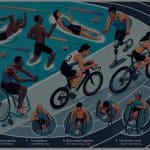The autonomous vehicle industry is revving up, and as we lurch closer to a future of self-driving cars, a vital question emerges: how do we teach these vehicles to drive safely and efficiently? Enter reinforcement learning models, the driving school for autonomous vehicles.
With artificial intelligence (AI) in the form of reinforcement learning, autonomous vehicles can learn to adapt and respond to driving conditions in ways that are increasingly similar to us, human drivers. Yet, how exactly are reinforcement learning models shaping the training of autonomous vehicles?
Also read : Can Deep Learning Models Improve Early Detection of Diseases in Medical Imaging?
Reinforcement Learning Models: A Primer
Before we dive deep into learning’s role in driving autonomous vehicles, let’s first understand what reinforcement learning models are.
Reinforcement learning is a type of machine learning where an agent learns how to behave in an environment by performing actions and seeing the results. The agent learns from trial and error, receiving rewards for correct actions and punishments for incorrect ones.
This might interest you : What Innovations in NLP Models Are Revolutionizing Customer Service Chatbots?
In the context of autonomous vehicles, the agent is the car’s AI system, and the environment is the road with all its variables – traffic, pedestrians, weather conditions, and more. The goal is to control the vehicle in a way that maximizes safety and efficiency.
Deep Reinforcement Learning for Autonomous Cars
Deep reinforcement learning brings together two powerful AI approaches: reinforcement learning and deep learning. It uses neural networks to interpret raw input data, allowing the agent to respond to complex environments.
In the world of autonomous cars, this means the vehicle’s AI system can process vast amounts of data in real-time, making decisions based on the current driving situation. By repeatedly interacting with the environment – braking, accelerating, turning – the autonomous car can learn which actions lead to the best outcomes.
An example of this is the DDPG (Deep Deterministic Policy Gradient) model. DDPG is a model-based approach that uses neural networks to predict future states and rewards. This ability to anticipate potential outcomes helps the agent – the autonomous car – make decisions that promote safety and efficiency.
The Role of Data in Training Autonomous Vehicles
Data, the fuel that powers learning models, plays a crucial role in training autonomous vehicles. The more data the model has to learn from, the better its performance.
For instance, data collected from sensors, cameras, and radars mounted on the car provide a real-time view of the vehicle’s surroundings. This data is then used by the reinforcement learning model to make decisions about how the car should respond to its environment.
Moreover, data from countless hours of human driving can be used to teach the model various driving strategies. By learning from human behaviour, autonomous cars can acquire the subtle skills that make us proficient drivers, such as anticipating other drivers’ actions.
Reinforcement Learning and Safety in Autonomous Cars
The ultimate goal of using reinforcement learning in autonomous vehicle training is to improve safety. Through constant interaction with their environment, autonomous cars learn to make decisions that minimize risk and prevent accidents.
For instance, they can learn to maintain a safe following distance, to slow down in response to unpredictable pedestrian behaviour, or to adjust their driving in poor weather conditions. By continually learning from their experiences, autonomous cars can continuously improve their safety performance.
It is also worth noting that reinforcement learning models can be trained in simulations before being tested in the real world. This allows them to learn from risky scenarios without posing actual danger, making the training process safer.
The Future of Autonomous Vehicles: A Learning Journey
While we’ve made significant strides in autonomous vehicle technology, there’s still a long road ahead. The advancement of reinforcement learning models and their application in autonomous vehicle training are likely to be a key part of this journey.
Different models will continue to evolve, offering greater precision and adaptability. The integration of more advanced sensors will provide richer data for these models to learn from. And as these vehicles learn and adapt to the complexities of real-world driving, we’ll see a continuous improvement in their safety and performance.
Remember, teaching an autonomous vehicle to drive is not a one-time task, but a continuous learning process. As we navigate this fascinating realm of AI and machine learning, it’s clear that the future of autonomous vehicles is not just about technology, but about learning. Reinforcement learning models are not just the engine, but also the driver, taking us closer to a future where autonomous vehicles are a common and safe mode of transportation.
Advanced Reinforcement Learning Models in Development
As the field of reinforcement learning continues to evolve, researchers and developers are working on more sophisticated models that can better equip autonomous vehicles for the challenges of real-world driving. A prominent example is the Actor-Critic model, which is steadily gaining attention in the autonomous driving industry.
The Actor-Critic model, sometimes referred to in Google Scholar and arXiv Google publications, operates on the premise of two neural network models working in tandem. The actor is responsible for deciding the best action based on the current state, while the critic evaluates the decision made by the actor by comparing it to the ideal action.
In the context of autonomous vehicles, the actor might decide to change lanes based on sensor data, and the critic would then evaluate this decision based on the overall safety and efficiency. This ongoing feedback loop enables continuous decision-making improvements, enhancing the safety and efficiency of the driving car.
The Actor-Critic model and its variants are a part of a larger group of reinforcement learning algorithms known as deep deterministic policy gradient (DDPG) models. These models are increasingly being utilized in the training of autonomous vehicles due to their ability to handle continuous state and action spaces, making them an ideal fit for the complex task of autonomous driving.
Conclusion: Reinforcing the Road Ahead
The journey towards a future dominated by autonomous vehicles relies heavily on the advancements in reinforcement learning and deep reinforcement learning models. Through tireless iterations of trial and error, these models are teaching autonomous vehicles to drive more like humans, reacting adaptively to changes in their environment, and making calculated decisions designed to maximize safety and efficiency.
The incorporation of machine learning models like DDPG and Actor-Critic into autonomous vehicle training represents a significant milestone in autonomous driving development. These models’ ability to learn from vast amounts of data, simulate risky scenarios, and continuously improve their decision-making capabilities paints a promising picture for the future of autonomous vehicles.
However, the road to fully autonomous driving is far from smooth, with technical challenges and regulatory hurdles yet to be overcome. Reinforcement learning models will need to continue evolving to address edge cases and unexpected scenarios encountered during real-world driving.
As we move forward, the focus on safety should remain at the forefront of all developments. Autonomous vehicles offer the potential to drastically reduce road accidents caused by human error, but achieving this requires the effective application of reinforcement learning models.
Thus, the journey continues. As autonomous vehicles inch closer to being a common and safe mode of transportation, reinforcement learning remains the driver behind the wheel, steering us towards a future of safer, more efficient, and truly autonomous driving.











